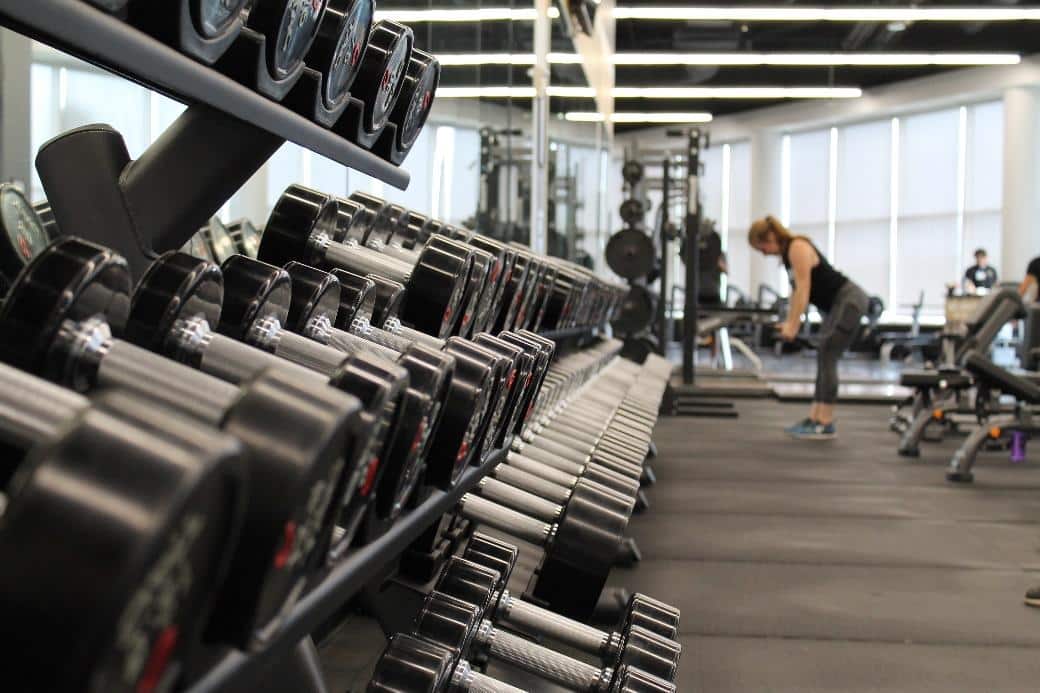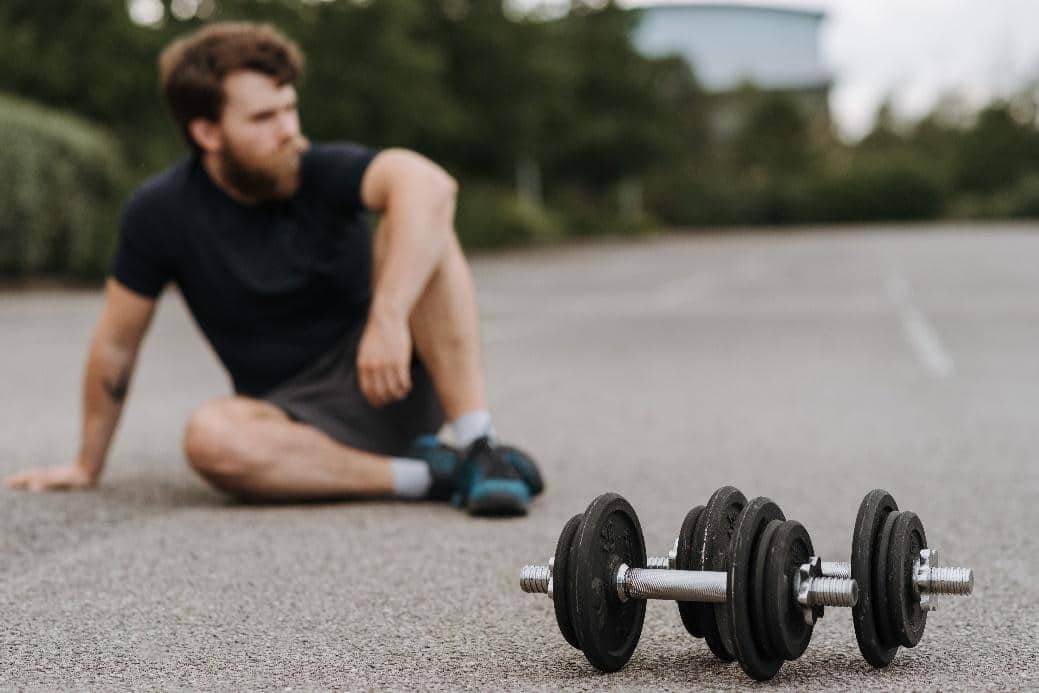8 de January de 2024
Full Body Dumbbell Workout: Sculpt and Tone
Full Body Dumbbell Workout: No Gym Machine Required

Centuries ago, the current gym machines we see today did not exist. Nevertheless, you’ve probably walked through a museum showcasing sculptures of muscular Greek athletes. Recently, a group of researchers delved into the traditional myth suggesting that machines are better for gaining muscle mass. Their conclusions were that “free weight and machine-based modalities are equally effective in promoting strength and hypertrophy without increasing joint discomfort” (Hernández-Belmonte, Martínez-Cava, et al., 2023).
[banner_device_2]
Prior to their study, but also recently published, another group of researchers found that adaptations in athletic performance and muscle architecture are not significantly influenced by free weight training versus machine exercises (Hernández-Belmonte, Buendía-Romero, et al., 2023). That’s why Greeks over two millennia ago could achieve sculpted and toned bodies similar to those obtained naturally today.
In this article, we propose a full-body dumbbell workout that only requires adjustable dumbbells or a set of dumbbells. No machines or additional equipment are necessary, apart from an adjustable bench for some exercises.
How to Perform the Full Body Dumbbell Workout We Propose

Full body training, or full body, has advantages and disadvantages when it comes to improving our body composition. The advantage is that we stimulate all the muscles in a single training session. The disadvantage is that the volume per session is high, so we have to choose between doing fewer exercises and leaving some muscle groups untouched, or doing them all with fewer sets each.
Our proposal is to perform one exercise for each muscle group, although we could also choose compound exercises that involve more muscles per movement. In this case, we divide the exercises into four main groups: lower body (hamstrings, quadriceps, and glutes), upper body pushes (chest, shoulder, and triceps), upper body pulls (back and biceps), and core (frontal flexion, lateral flexion, and trunk rotation).
In each group, there are three exercises, making a total of 12 movements, so it would be very slow if we did each one separately, as we would have to introduce a pause between sets. Instead, we are going to train in a circuit manner, organizing the exercises so that the trained muscle group rests while we stimulate other muscles. This way, we will have three circuits of four exercises each: one lower body exercise, one upper body push exercise, one upper body pull exercise, and one core exercise.
[banner_device_1]
The rest between one exercise and the next in the circuit will depend on your physical level and the exercise itself. For example, you will need more rest after a Romanian deadlift than after a dumbbell bicep curl. The idea is to rest for the minimum time you need to face the next set with the maximum guarantees. That could be a rest of 10 seconds or 30 seconds. It will also depend on whether you are at the beginning of the training or in the final part, as with more fatigue, you may need to rest a little longer. That is why we do not establish a fixed rest between exercises.
What you will do is rest between three and five minutes between one circuit and the next. That time will be used to catch your breath and prepare for the next set of exercises, but only once the determined rounds of each circuit are completed. Each set of exercises, or circuit, should be performed between three and five times depending on your physical level. If your level is very low, you can even do only two rounds of each circuit; if your level is very high, you can add a few more rounds per circuit.
Exercises in Full Body Dumbbell Training

As mentioned earlier, full body dumbbell training consists of four groups of exercises, with three exercises in each group. To create the circuits, we will select one exercise from each group, ensuring that we cover movements that primarily stimulate the legs, upper body pushing muscles, back and biceps, and the core or abdominal area.
Lower Body
- Romanian Deadlift: emphasis on hamstrings
- Bulgarian Split Squat: emphasis on quadriceps
- Reverse Hyperextensions: emphasis on glutes
Upper Body Pushes
- Dumbbell Bench Press: emphasis on chest
- Dumbbell Standing Military Press: emphasis on shoulders
- Dumbbell French Press: emphasis on triceps
Upper Body Pulls
- Seal Row: emphasis on back
- Dumbbell Pullover: emphasis on back
- Dumbbell Bicep Curl: emphasis on biceps
Core
- Turkish Get-up: engages all core planes
- Windmill: emphasis on obliques
- Wood Choppers: emphasis on obliques and trunk rotation muscles
This is how the full body dumbbell workout looks like

Although we have previously described the methodology of full body dumbbell training, we briefly summarize it again here. The training consists of three circuits, each with four exercises that target different major muscle groups. You should perform the first exercise of the circuit, rest for the minimum time necessary to tackle the next exercise effectively. Once you have completed all four exercises of the circuit, you have finished one round or set of it. At that point, the rest period remains minimal to return to the first exercise of the circuit.
Continue in this manner until you complete between three and five rounds of the circuit, depending on your physical level. Once completed, rest for three to five minutes to catch your breath and prepare for the next circuit. We will repeat this in the same way, as the exercises are selected to allow rest for some muscles while training others. Once you complete all rounds of each circuit, you have finished the full body dumbbell training.
Circuit 1
- Dumbbell romanian deadlift (vídeo)
- Dumbbell bench press (vídeo)
- Seal row (vídeo)
- Turkish get up (video)
Circuit 2
- Bulgarian squat (vídeo)
Circuit 3
An Extra? Physical Conditioning
If you’ve chosen challenging weights and completed enough rounds of the circuits, you may not feel like doing more, but like dessert after a meal, there might be room for one last push. Although you’ll be sweating from the density of the workout (a lot of work in a short time), this part of physical conditioning aims to maximize heart rate through high-intensity interval training.
There are many repetition schemes and types of training that can be done, but we’ll stick to two shorter ones, as the idea is to do this “bonus track” in the same session. Here are the two dumbbell conditioning workouts we propose. Choose between one or the other to perform after completing all rounds of the previous three circuits.
Tabata: Short but Sweet, Twice as Nice
Tabata is a high-intensity interval training method designed by its namesake author. It lasts only four minutes, but if you haven’t tried it yet, you’ll find that four minutes can feel very long. During these four minutes, work and rest are alternated in blocks of 30 seconds. Each 30-second block consists of 20 seconds of work and 10 seconds of rest. The blocks are repeated eight times, resulting in a total of four minutes.
Perform one of the following exercises in each 30-second block, and repeat again after completing all four. The goal is to perform the maximum number of repetitions for each exercise and add them up at the end. The next day, you’ll need to try to surpass that number with the same weight, or perform the same number of repetitions with heavier weight. If you prefer to do fewer exercises per Tabata, you can select two and alternate between them, or even do a Tabata with a single exercise repeated eight times.
- Dumbbell power snatch (vídeo)
- Dumbbell thrusters (vídeo)
- Burpees devil press (vídeo)
- Sumo deadlift high pull (vídeo)
- Repite de nuevo la misma secuencia
Modified ‘Fight Gone Bad’: Do as Many Repetitions as You Can per Minute of Each Exercise
The second option we propose consists of the same four exercises, but in this case, the scheme is different. Each minute, you must do the maximum number of repetitions of the same exercise. Once the minute is over, you’ll move to the next exercise without resting. You’ll determine the rest in this scheme yourself; however, if you start too strong, you’ll quickly run out of steam, so it’s better to pace yourself.
- 1’ Dumbbell power snatch (vídeo)
- 1’ Dumbbell thrusters (vídeo)
- 1’ Burpees devil press (vídeo)
- 1’ Sumo deadlift high pull (vídeo)
[banner_guide]
References
Hernández-Belmonte, A., Buendía-Romero, Á., Franco-López, F., Martínez-Cava, A., & Pallarés, J. G. (2023). Adaptations in athletic performance and muscle architecture are not meaningfully conditioned by training free-weight versus machine-based exercises: Challenging a traditional assumption using the velocity-based method. Scandinavian Journal of Medicine & Science in Sports, 33(10), 1948–1957. https://doi.org/10.1111/SMS.14433
Hernández-Belmonte, A., Martínez-Cava, A., Buendía-Romero, Á., Franco-López, F., & Pallarés, J. G. (2023). Free-Weight and Machine-Based Training Are Equally Effective on Strength and Hypertrophy: Challenging a Traditional Myth. Medicine & Science in Sports & Exercise. https://doi.org/10.1249/MSS.0000000000003271
